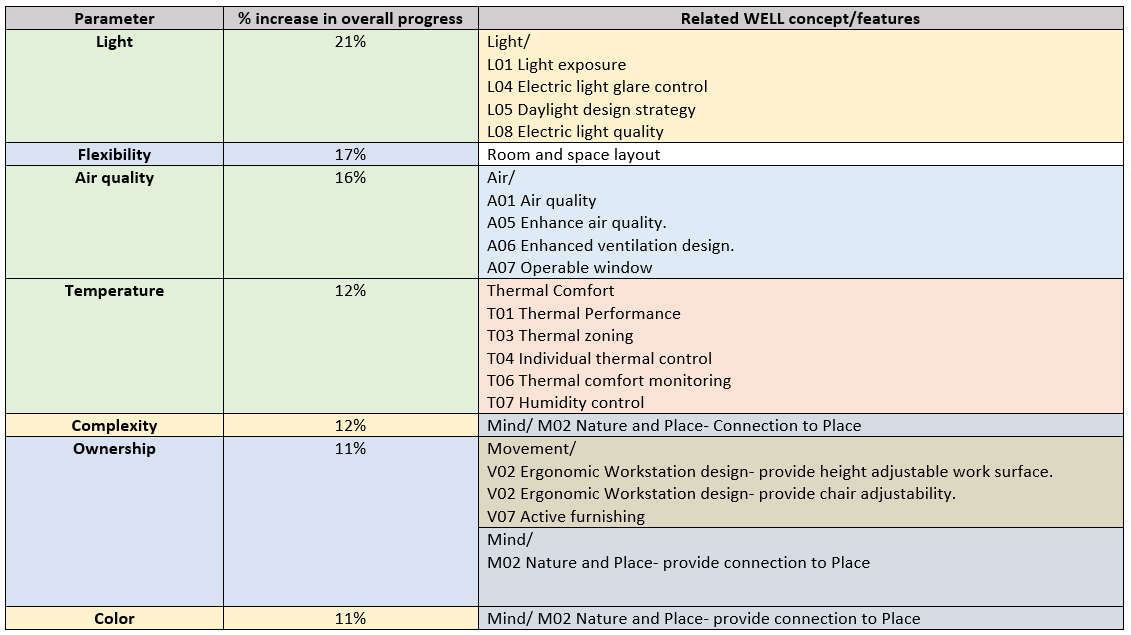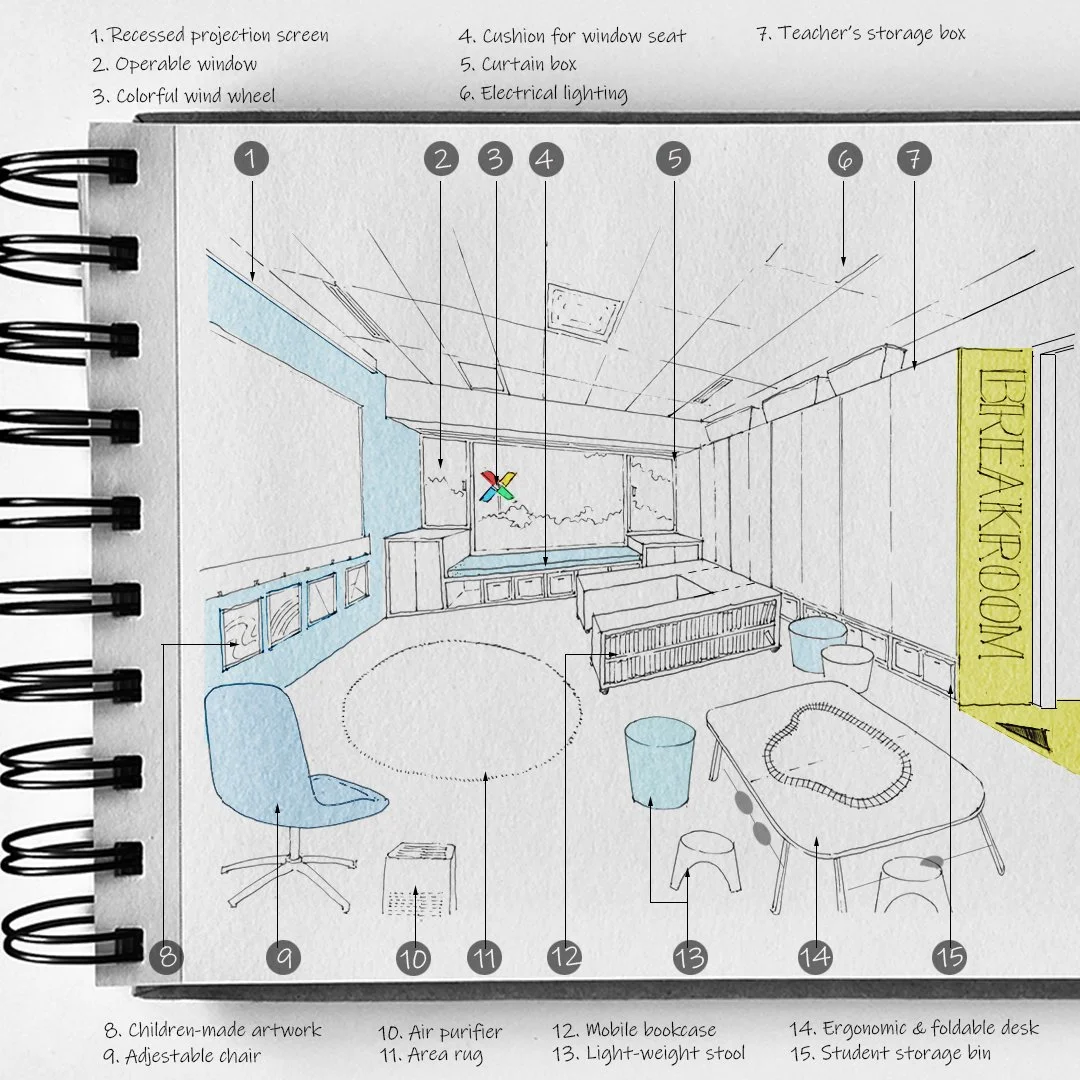WELL is a standard published in the building industry, yet it primarily focuses on human comfort and well-being. WELLv2 is structured around these ten concepts (Air, Water, Nourishment, Light, Movement, Thermal comfort, Sound, Materials, Mind, Community, and Innovation). Each concept encompasses various features with distinct health intent.
The WELL concepts and related features are primarily designed for adults and the workplace, yet I was curious if their impact remains the same in children. Simultaneously I stumbled upon this research paper from Peter Barrett of the University of Salford in the U.K. It summarized all the critical design elements regarding early children's learning environment. Therefore, I wanted to highlight several findings from this paper that might benefit how we implement WELL standards in the future.
Why is Barrett's research worth noting?
The research was conducted over a more extended period.
Before this paper was published, Barrett had done a similar and comprehensive analysis for the first phase. The first experiment and assessment were done in 2013 and covered 751 pupils within 34 classrooms.
The study has a larger sample size.
His sample size increased almost five times in the study's second phase, which included 3 areas, 27 schools, 153 classrooms, and 3766 pupils.
The research focuses on early childhood education and the built environment.
There are numerous studies on how the class environment relates to students' learning performance. However, only a handful focus on early childhood learning performance.
According to Healthy People 2030, data-driven national objectives, 'social determinants of health,' is the primary focus of our health and well-being in the next decade. In its selected literature, early childhood education (particularly the first five years of life) has a long-term impact on many adults' lives afterward. High-quality early childhood education can increase earning potential and support academic attainment. Thus, determining what influences made early education a high-quality opportunity is essential for the next generation's overall health and well-being.
What are the connections between Barrett's study and the WELL features?
In Barrett's environment-behavior model, three dimensions (aka the design principle) have been used to structure his study and measurement: Naturalness, Individualization, and Stimulation. And each of them constitutes several factors. To understand how his environment-behavior model correlated with WELL concepts, refer to the following table.
What can we learn from Barrett's findings?
First, the environmental factor has a greater impact than students' characteristics on their learning performance. The finding shows that overall learning progress is highly correlated with environmental factors than with pupils themselves' characteristics, such as height, weight, or free school meals (refer to the study's Table 6, Pearson correlation between each variable and each pupil's overall progress)
Second, naturalness impact more than other environmental sensory factors. In Barrett's assessment sample, the naturalness sensory accounts for around 50% of the impact on learning, and the 'individualization' and 'Stimulation' accounts for roughly 25% of the learning result.
Last, light has the most positive impact on students' learning than other factors. Seven of the ten environmental parameters investigated in this study significantly improved pupils' overall progress. We can apply these principles in the future learning space. In the following table, I restructured their influence based on the research's final findings.
What's the takeaway?
The environment impacts students' comfort and influences occupants' mental states, which leads to students' engagement and reflects on their learning performance. When the teaching focuses more on a student-centered curriculum, typical in an elementary school setting, it is crucial to introduce the sensory aspect of the built environment. For example, the better ergonomics of desks and chairs reduce students' muscle stress and make them feel more comfortable during class hours. Because students' disruptive behavior decreases with the proper furnishing, they become more engaged and focus on the teacher more. They also would feel empowered if they controlled their learning environment at a certain level.
What kind of learning environment could we expect in the future? If we follow his study and prioritize those influential building design parameters, we can create the following space. Once children are mentally and physically well, it is not surprising to see students' engagement increase and their learning performance grow.
In general, "rooms with white walls with highlighting of a feature wall had the best correlation with learning progress. A brightness color scale was used to distinguish color elements. Added color elements in the room with bright color furniture also correlated with learning progress." —Insights from main study results/ Barrett, P. (2015)
Descriptive details of the drawing:
Recessed projection screen: for FLEXIBILITY-use layout to set the appropriate stage.
Operable window: for LIGHT/ AIR QUALITY. (L01, L05/ A07)
Colorful windwheel: for COLOR/ MIND-use integration of art and human delight to make the connection to place. (M02)
Cushion by the window: for LIGHT/ MIND- gain quality natural light and view towards nature to make the connection.(L01, L05/ M02)
Curtain box: for LIGHT/TEMPERATURE- additional shading device to reduce risk of glare. Draw up thick fabric, such as velvet, during the night to properly insulate the classroom; or during the event of excessive noise from the outside. (L01, L05/T01)
Electric lighting: for LIGHT-full spectrum lamps positively correlates with pupil learning progress. (L04, L08)
Teacher's storage box: for OWNERSHIP- teachers can increase their teaching tool collection with added storage. It also helps demonstrate a model behavior, so students learn how to store their stuff regularly. (M02)
Children-made artwork: for OWNERSHIP- personal display made by pupils creates a sense of ownership, which was significantly correlated with learning progress. (M02)
Adjustable chair: for OWNERSHIP- ergonomic and quality furniture appropriate for both age groups. (V02)
Air purifier: for AIR QUALITY- the level of CO2 is correlated with learning progress. (A01)
Area rug: for OWNERSHIP- use the element to identify the space and make it children-centered, which is significantly correlated with learning progress. (M02)
Mobile bookcase: for FLEXIBILITY- more learning zones for younger children correlated with learning progress.
Lightweight stool: for OWNERSHIP- use light furniture so pupils can quickly move and feel empowered to control their environment. Use the ergonomic-designed chair so that students feel comfortable and safe to wiggle. That decreases pupils' disruptive behavior and increases student engagement. (V02/ M02)
Foldable desk: for OWNERSHIP/FLEXIBILITY- a designed element to identify the space; play-based learning zones for younger children positively correlated with learning progress. (M02)
Student storage bins: for FLEXIBILITY- storage solution and breakout space increase the degree to which students have an appropriate provision of space.
Notes and references
Barrett, Peter, A holistic, multi-level analysis identifying the impact of classroom design on pupils' learning (Building and Environment 89, 2015, p118-133) via Researchgate.net.
The WELL standard I am referring to here is version 2. Link Standard I WELLv2 for online access.
For more in-depth of air quality information, see "6 Strategies to improve indoor air quality" For more information on how to select a proper indoor air purifier, check out Curious C's "How to pick a portable air cleaner."
See Literature Summaries on Early Childhood Development and Education via Healthy People 2030 for more comprehensive science literature on early childhood education.




